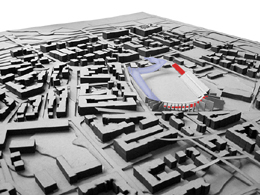STUDENTS PROJECTS
PROJECTS2013

20 February, 2015
Stadium in the city
Architectural reform and addition to the stadium of Panionios in New Smyrni.
Student : Alkistis Krousti
Supervising professor: Κ. Moraitis
Advisors: Μ. Μarkou, H. Gantes
National Technical University of Athens
Presentation date : July 2014
In the course of this thesis project, the goal has been the emergence and rapprochement of a significant sport center, from the point of view of a functional and visual connection with the surrounding space. For the proposal FIFA requirements were used as a basis, with adjustments to meet the smaller scale of the stadium in question.
The stadium is one of great importance to the neighborhood of Nea Smyrni, as it comprises a very essential attraction pole that exceeds local interest. Its particularity mainly lies on its location, in the middle of a thick urban tissue, surrounded by small to medium height buildings of dueling and commercial use.


REFORM
The issue of reform was put forward due to the bad current condition of the stadium, whose construction, fitting 11.700 spectators, has accrued as a collage of different interventions, from 1939 up to now and has undergone a lot of damage. In this respect, the proposal involves the preservation of a large part of the structure as well as the reform of the spaces underneath the seats and the addition of new volumes, hosting administration and public related functions.
A series of problems had to be faced, concerning in particular the three following issues:
- The integration, as far as extroversion towards the neighborhood and the relative scale are concerned
- The consolidation of different parts into one functional whole
- The efficient structure of a variety spaces and crowd circulations
The stadium under its present conditions of use addresses to three main categories of users:
- General public
- Athletes and employees
- Fans and sport reporters during matches
As far as the neighborhood is concerned, emphasis was put on the attribution of a more public character to the entire currently closed square, through the pedestrianization and the opening of the adjacent streets, so that the stadium would be peripherally accessible. Additionally, part of the proposal is the landscaping of the free space central to the square as a public space, to function as an expansion to the space underneath the seats.
As far as the form was concerned, the main goal has been the smooth integration of a structure of such a massive structure to the neighborhood, so that it preserves its landmark character, but at the same time be in a constant dialog with the city rhythm. This was accomplished by the partial decomposition of the volume of the structure, by the addition of a series of vertical wall elements that create smaller spaces where boxes of distinct functions are placed. These elements add functional and visual continuity, by the repetition in a rhythm that changes to adjust to that of the existing structure (varying from 7.80 to 4.75m of height).
Another fundamental goal has been the increase of extroversion, by attributing public-related functions to the external periphery of the stadium. In the same direction, an intense passage was created leading from outside to underneath the seats and through the petal to the inside of the stadium, purposed for controlled public use, during opening hours.
Finally, the unification that was called for is completed with the construction of a canopy, covering the northwest part of seats, expanding over the open courts and the swimming pool, thus running all through the square in an S-shape.
The resulting composition is thus organized in four layers:
1. The sequence of vertical concrete elements, as a visual reference to the existing structure
2. The central semi-public passage running through the whole upper level, leading from outside in the main field.
3. The perforated metallic boxes hosting administrative and public- related uses.
4. The S-shaped canopy





THE CANOPY
The concept for the canopy was a folded structure that meanders, creating different qualities of space underneath. The form finding procedure was parametrically aided by grasshopper, given the demanded plan view and the positioning of load bearing elements.

In collaboration with mr. Gantes, from the Metal Structure Lab, in the Civil Engineering Department, the particular L shaped elements were defined, structurally independently from the rest of the structure. The filling is made by metal panels on each side of the beams, and the rainwater is removed through a linear gutter. As for the dimensioning, the canopy was set for calculation as part of a group project in the post-graduate course of hanging structures, but due to changes in the study program, the final calculations were performed with the help of mrs. G. Margariti.











